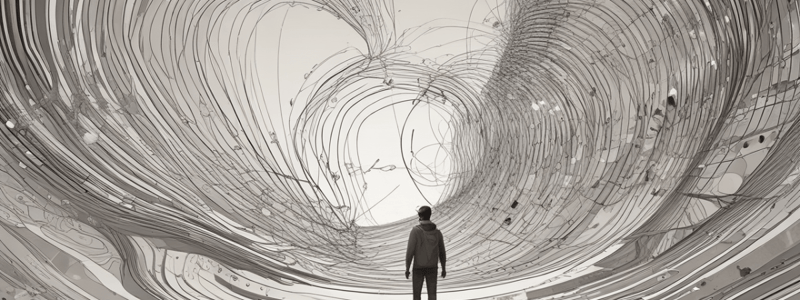Podcast
Questions and Answers
What is the formula to find the total distance travelled from a velocity-time graph?
What is the formula to find the total distance travelled from a velocity-time graph?
- The intercept of the v-t graph
- The area above the v-t graph
- The slope of the v-t graph
- The area underneath the v-t graph (correct)
What is the ratio between the accelerations of an object accelerating from rest in a time t1 and decelerating back to rest in a time t2?
What is the ratio between the accelerations of an object accelerating from rest in a time t1 and decelerating back to rest in a time t2?
- t1^2 : t2^2
- t1 : t2^2
- t2 : t1
- t1 : t2 (correct)
Two objects are moving towards each other with different initial velocities. What is the distance between them?
Two objects are moving towards each other with different initial velocities. What is the distance between them?
- The sum of the objects’ initial velocities
- The product of the objects’ displacements from a shared origin point
- The sum of the objects’ displacements from a shared origin point (correct)
- The difference between the objects’ displacements from a shared origin point
What is the condition for one object to overtake another?
What is the condition for one object to overtake another?
What is the acceleration due to gravity near the Earth’s surface?
What is the acceleration due to gravity near the Earth’s surface?
What is the easiest way to find the area underneath a v-t graph?
What is the easiest way to find the area underneath a v-t graph?
What is the condition for one object to fully pass another?
What is the condition for one object to fully pass another?
What can velocity-time graphs show?
What can velocity-time graphs show?
What is the quantity that links the five important quantities of motion?
What is the quantity that links the five important quantities of motion?
What is the assumption made for objects accelerating from rest and decelerating back to rest?
What is the assumption made for objects accelerating from rest and decelerating back to rest?
Flashcards are hidden until you start studying
Study Notes
Equations of Motion
- Describe motion using 5 quantities: displacement (s), initial velocity (u), final velocity (v), acceleration (a), and time taken (t)
- Four equations link these quantities together
Velocity-Time Graphs
- Display information about an object's changing speed over time
- Can show velocity, acceleration, and distance traveled
- Area underneath v-t graph gives total distance traveled
- Split shape into triangles and trapezoids to find area easily
Rest to Rest
- Object accelerates from rest in time t1 and decelerates back to rest in time t2
- Ratio of accelerations equals ratio of times
Two Bodies - Moving Towards Each Other
- Distance between two bodies is sum of objects' displacements from shared origin point
Catching Up
- Object will overtake another when both have same displacement from a certain point
- If one object starts ahead, add distance to equation
- If objects start at same point but at different times, add time difference to equation
Passing
- One object must cover distance equal to total length of both objects to fully pass the other
- Difference in displacements of both objects must equal this distance
Acceleration due to Gravity
- Only force acting on an object in free fall is gravity
- Gravity causes objects to accelerate towards the ground at constant 9.8 m/s2 near Earth's surface
- Steps for a free fall question:
- Identify equation of motion with one unknown variable
- Substitute known values, including a = -9.8 m/s2
- Solve for unknown; for maximum height, speed is 0
Studying That Suits You
Use AI to generate personalized quizzes and flashcards to suit your learning preferences.




